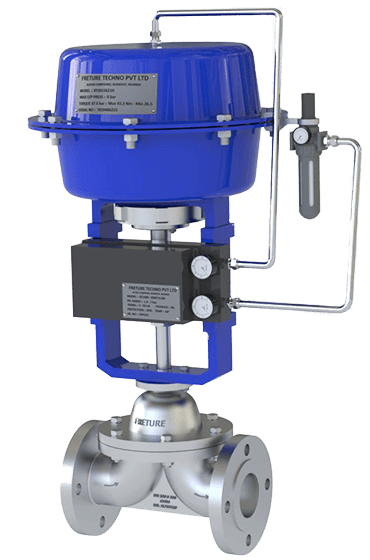Control valves play a critical role in regulating fluid flow, pressure, and temperature in industrial processes. To function effectively, these valves require actuators—devices that convert energy into mechanical motion. Among the various types of actuators, piston-type actuators and spring diaphragm-type actuators are two of the most widely used. Each has distinct advantages and is suited to specific applications. Understanding the key differences between them can help in selecting the right actuator for a given process.
1. Overview of Piston-Type Actuators
A piston-type actuator operates using compressed air, hydraulic pressure, or other external power sources to move a piston inside a cylinder. This movement generates a force that controls the valve’s position, enabling precise regulation of fluid flow.
Key Features:
Uses compressed air or hydraulic fluid to create motion.
Generates high force output, making it ideal for large or high-pressure valves.
Typically operates in double-acting or single-acting configurations.
Provides fast response times for rapid valve positioning.
Suitable for applications requiring high thrust and durability.
Advantages:
Higher force output: Piston actuators generate greater force than diaphragm actuators, making them suitable for high-pressure systems.
Compact design: Their design is more space-efficient compared to diaphragm actuators for the same force output.
Precise control: These actuators are ideal for applications requiring accurate positioning and high-speed operation.
Suitable for harsh environments: Can handle extreme pressures and temperatures with the right material selection.
Disadvantages:
Higher cost: Typically more expensive due to additional components and complexity.
Requires more maintenance: Moving parts, seals, and hydraulic/pneumatic systems may require frequent servicing.
Potential for leakage: Hydraulic or pneumatic fluid leaks can pose operational challenges.
2. Overview of Spring Diaphragm-Type Actuators
A spring diaphragm-type actuator relies on air pressure acting against a diaphragm, which moves a stem to control valve position. A spring provides a fail-safe mechanism, ensuring that the valve returns to a specific position when air pressure is lost.
Key Features:
Uses air pressure to move the diaphragm and control valve position.
Incorporates a spring return mechanism for fail-safe operation.
Typically single-acting, with air applied to one side of the diaphragm.
Designed for smooth and stable operation, minimizing control fluctuations.
Often used in modulating control applications.
Advantages:
Fail-safe design: The spring ensures that the valve moves to a predetermined position during air supply failure, enhancing safety.
Lower air consumption: Requires less compressed air compared to piston-type actuators, making it more energy-efficient.
Smoother control: Ideal for precision flow modulation, reducing overshoot and instability.
Lower cost and maintenance: Fewer moving parts mean reduced wear and minimal servicing.
Disadvantages:
Limited force output: Not suitable for high-pressure valves or applications requiring high thrust.
Slower response time: Compared to piston actuators, diaphragm actuators may have a slightly delayed reaction time.
Bulkier design: Requires a larger housing to accommodate the diaphragm and spring.
3. Key Differences Between Piston-Type and Spring Diaphragm-Type Actuators
| Feature | Piston-Type Actuator | Spring Diaphragm-Type Actuator |
|---|---|---|
| Power Source | Pneumatic or hydraulic | Pneumatic only |
| Force Output | High force output, suitable for high-pressure valves | Lower force output, best for low to medium pressure |
| Control Speed | Fast response, precise movement | Smoother but slower control |
| Fail-Safe Operation | No built-in fail-safe; external mechanisms required | Built-in spring return ensures safety in case of failure |
| Maintenance | Requires regular maintenance for seals and pistons | Lower maintenance due to fewer moving parts |
| Energy Efficiency | Higher air consumption | More energy-efficient |
| Best Applications | High-thrust, rapid response, harsh environments | Precision control, modulating applications, energy efficiency |
4. Choosing the Right Actuator for Your Application
The choice between a piston-type actuator and a spring diaphragm-type actuator depends on the specific requirements of the control system:
If high thrust, rapid movement, and durability are required, a piston-type actuator is the better choice.
If smooth operation, energy efficiency, and fail-safe functionality are more important, a spring diaphragm-type actuator is ideal.
For high-pressure applications, where the valve must overcome large forces, a piston actuator is recommended.
For modulating control, where precise valve positioning is needed, a diaphragm actuator is preferred.
5. Conclusion
Both piston-type actuators and spring diaphragm-type actuators play a vital role in control valve automation, each with distinct benefits and limitations. Piston actuators provide high force, precision, and durability, making them suitable for demanding applications. Spring diaphragm actuators, on the other hand, offer fail-safe operation, energy efficiency, and smooth modulation, making them the preferred choice for many control applications.
Understanding these differences ensures that industries select the most efficient and cost-effective actuator for their process needs. Whether for high-pressure steam control, chemical processing, or HVAC systems, the right actuator can enhance system performance, reliability, and safety.

No comments:
Post a Comment